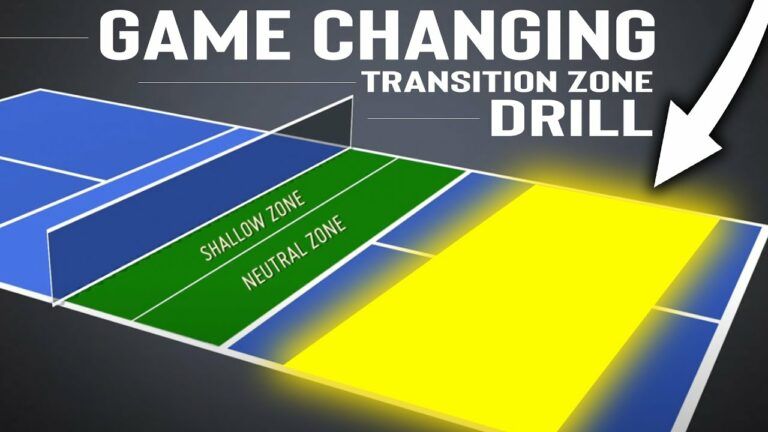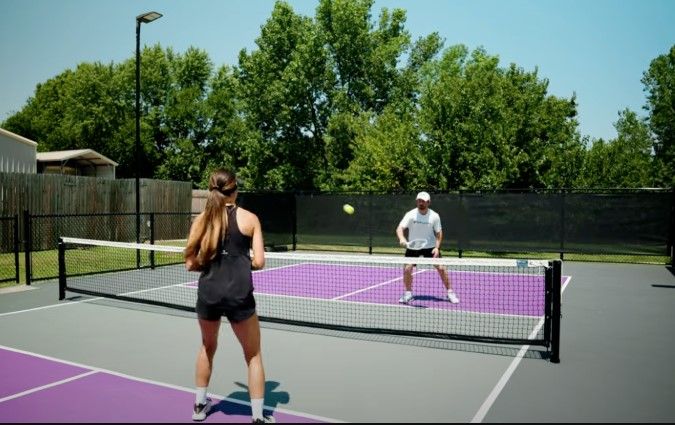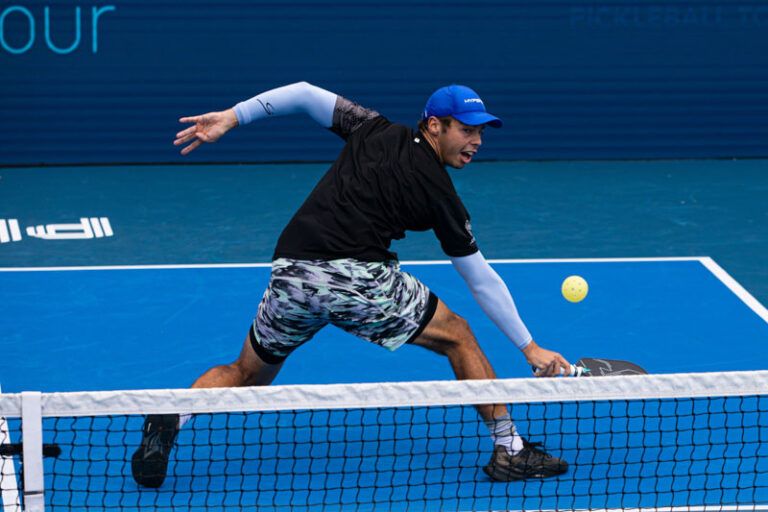Understanding the Pickleball transition zone
The transition zone is a geographical spot on the pickleball court that plays a significant role in a player's performance. It is situated between the baseline and the non-volley zone (kitchen line) and can often feel like a precarious space, where decisions can lead to either a well-executed play or an ill-fated mishap. Players must recognize its strategic importance as they delve deeper into their overall game strategy.
What is the transition zone?
In pickleball, the court dimensions are defined clearly, with specific lines marking various areas that dictate play. The baseline is the farthest boundary a player can retreat to for a defensive shot. Conversely, the non-volley zone (or kitchen line) is where players cannot hit the ball in the air but must allow it to bounce first. This transition zone, often overshadowed by its more prominent neighbors, serves as a vital point of movement for players, functioning nearly like a bridge connecting these two critical areas.
This area is neither entirely secure nor openly aggressive. Therefore, mastering its nuances can offer players an edge in gameplay, helping to control rallies and improve strategic play. Understanding how to move and position oneself within this zone translates into more effective scoring opportunities.

Why is the transition zone crucial?
Effective control in the transition zone can redefine a player's ability to win points during a match. It can turn the tide of a rally from defensive to offensive by providing access to the kitchen line. A well-executed approach through this area can lead to forcing errors from opponents or creating opportunities for strategic placement of shots.
Players who neglect this area may find themselves vulnerable, as lingering can give opponents time to set up aggressive shots. The goal is to seize control of the point by maintaining momentum and making calculated movements toward the net, establishing a dominant presence.
Debunking transition zone myths
There are several misconceptions surrounding the transition zone, primarily rooted in its derogatory name "no man’s land." Many players view this area as a hazardous zone where they can fall prey to powerful shots. However, reframing this mindset is crucial. Instead of viewing it as a perilous territory, players should see it as a land of opportunity where they can refine their transition to the kitchen.
Understanding these myths allows players to approach the transition zone with the strategy and foresight needed to leverage this space, turning potential liabilities into assets.
Transition zone strategy: a mindset shift
Transitioning effectively requires a significant shift in mindset. Rather than viewing this zone as merely a passageway, elite players approach it as a potential launching pad for offensive plays. Shifting this perception can drastically change how players operate within this space.

From "no man's land" to "land of opportunity"
Renowned pickleball professionals, such as Tyson McGuffin, have championed the idea of reframing the transition zone from a place to avoid to an area to master. Through strategic foresight and proactive planning, players can utilize this space to create openings and dictate the course of a match.
By embracing a proactive strategy, players become more comfortable with their footwork and shot selection, allowing them to seize advantages rather than react defensively. This fellowship of readiness fosters an ambitious mindset that promotes confidence under pressure.
Avoiding common mistakes
One of the most common pitfalls players encounter in the transition zone is rushing the net without calculated intent. This uncontrolled movement often results in erratic shot placement or overcommitting, leading to errors. Players should emphasize maintaining balance and control, ensuring they remain grounded as they navigate this critical area.
Furthermore, it's paramount for players to minimize their chances of hitting out-of-bounds. Striving for precision in placements will significantly enhance their ability to take control of rallies and score points effectively.
Transitioning as a team
In doubles play, the transition zone requires seamless collaboration and communication between partners. Establishing clear communication cues can help partners cover gaps and coordinate movement, allowing them to maximize their strategies effectively. This synchronization not only fortifies a team's defensive posture but also creates gaps for aggressive offensive plays, ensuring both partners feel intimated by the dynamic of the zone.
Footwork mastery: control and precision
Footwork within the transition zone is foundational for success in pickleball. Players must develop controlled movement patterns that enable them to react quickly and effectively while transitioning between the baseline and the kitchen.

Controlled movement is key
Think of controlled movement as comparable to navigating the shifting sands of a beach; one must be deliberate with each step to avoid stumbling into danger. Players who adopt purposeful movements rather than rushing to the kitchen will find greater success in executing impactful shots. For example, players should avoid taking backward steps that can compromise their stability and balance.
Acknowledging the intricacies of footwork allows players to stay in tune with their physical movements, enhancing their overall agility and response time during rallies.
Mastering the split step
At the core of effective footwork lies the split step technique. Timing is critical, and making this movement an integral part of footwork enhances players' ability to react to opponents' shots. By adopting an athletic stance shoulder-width apart, weight distributed on the balls of the feet players can efficiently maintain balance while preparing for incoming shots.
This technique enables players to appropriately position themselves for defensive and offensive maneuvers, emphasizing the need for practice and refinement within the transition zone.
Advanced footwork techniques
Once players master the foundational principles of footwork, they can integrate advanced techniques such as shuffle steps, crossover steps, and pivots. These techniques expand court coverage and facilitate quick adjustments as situations arise. Emphasizing precision in footwork ultimately helps players achieve better positioning and ball placement, enabling them to navigate the transition zone with confidence.
Body mechanics: a foundation for success
Proper body mechanics are integral to navigating the transition zone effectively. Players must prioritize posture, weight distribution, and paddle readiness to ensure stability and responsiveness.

Optimal stance and weight distribution
In the transition zone, an optimal stance is crucial for successfully navigating the court. Adopting a shoulder-width stance with weight firmly placed on the balls of the feet ensures a low center of gravity, enhancing balance and stability. Players should avoid a flat-footed approach; instead, they should remain dynamic in their positioning, ready to react swiftly to opponents’ shots.
Paddle readiness and positioning
Paddle positioning is an often-understated element of success in the transition zone. By keeping their paddle in front, players enhance their anticipation of shots and improve their overall reaction time. As opportunities arise, quick readiness becomes a vital aspect of decision-making, allowing players to capitalize on openings when they occur.
Utilizing your non-dominant hand
Lastly, players should not underestimate the importance of their non-dominant hand. Utilizing this hand effectively ensures stability when digging out low shots or defending against overheads. By fine-tuning the coordination between both hands, players can enhance their overall gameplay, turning potential challenges into opportunities for success.
The reset shot: your neutralizing weapon
Navigating the transition zone often requires players to employ specific tactics, one of which is the reset shot. This shot serves as a neutralizing weapon, allowing players to regain control of the point and set themselves up for future plays.
The art of the reset shot
Executing the reset shot involves taking pace off the ball instead of delivering it aggressively. Players focus on employing "soft hands," enabling them to drop the ball into the kitchen delicately. This nuanced control can shift the momentum of the rally, forcing opponents onto the defensive.
Reset shot variations
There are several variations of the reset shot, which players can utilize based on situational factors:
- Soft reset: A gentle touch that arcs over the net, enticing the opponent into making mistakes.
- Deep reset: A shot that travels deep into the court, forcing opponents to move further back, creating space for future plays.
- Angled reset: A strategically angled shot that exploits weaknesses in the opponent's positioning.
These variations not only enhance shot selection but improve a player's adaptability within the transition zone.
Grip and paddle control
Another fundamental aspect of executing effective reset shots is proper grip and paddle control. Utilizing a continental grip enables players to maintain flexibility during their strokes. Combining this grip with loose grip pressure allows for more precise shot placement and short backswings, increasing the chances for accuracy.
Shot selection: expanding your arsenal
Mastering the transition zone encompasses not only footwork and body mechanics but also nuanced shot selection. Players must harness their awareness of the game to inform their choices when navigating this pivotal area.
Factors influencing shot choice
Several external factors can influence shot selection within the transition zone, including:
- Opponent's position
- Ball height
- Personal strengths and weaknesses
- Court awareness
Confident players leverage these factors to make informed decisions, ultimately enhancing their performance in this space.
Drop shots: precision and deception
Executing a drop shot is an art form that can result in effective placements that target opponent weaknesses. A well-timed drop shot can elicit errors due to its precision and subtlety. Players should aim to anticipate opponent positioning, utilizing drop shots effectively.
Drive shots: power and placement
Conversely, understanding when to employ a drive shot is equally essential in handling the transition zone. Players should use strategic drives aimed at forcefully pressuring their opponents. Forcing errors through calculated striking exemplifies advanced gameplay, particularly within this crucial area.
Exploiting opponent weaknesses
Reading opponents and anticipating movement is key in maximizing shot selection. Players should develop the expertise to exploit weaknesses, creating advantageous opportunities in the transition zone and increasing their chances for success.
Defense: turning the tables
Defensive strategies within the transition zone serve to protect and empower players against aggressive shots. Grounding oneself in efficient defense can halt opposing players’ attempts to capitalize on weakness.
Reading your opponent's shot
Anticipating shot direction and speed allows players to adjust and position themselves effectively. The split step timing becomes central to how players can react to an opponent’s attack, ensuring they are primed for a return.
Defending aggressive shots
A low center of gravity, combined with a wide stance, equips players with the ability to block and dig out volleys. These essential defensive techniques bolster a player's fortitude in the transition zone, turning potential vulnerabilities into opportunities for defensive triumph.
Creating defensive opportunities
Players can use the transition zone strategically to reset the pace of the match. Slowing the game, combined with a calculated response, forces the opponent into challenging positions and ultimately frustrates their attempts for quick points.
The mental game: confidence under pressure
The mental component of navigating the transition zone can often be overlooked, but it plays a significant role in player performance. Developing confidence, focus, and composure allows players to thrive in challenging situations.
Staying calm and composed
In moments of pressure, practicing breathing techniques and employing positive self-talk can go a long way in managing emotions. Remaining composed allows players to make better decisions and maintain strategic advantages.
Patience and earning your way to the net
Successfully navigating the transition zone requires patience, as rushing can lead to unforced errors. Players must focus on building points and waiting for advantageous opportunities before earnestly approaching the net.
Visualization for success
Mental imagery is a valuable tool for reinforcing player execution. By visualizing successful plays, players can improve focus and enhance confidence, ultimately translating to better performance within the transition zone.
Drills: sharpening your skills
Drills specifically targeting the transition zone can drastically improve a player's skillset, preparing them for real-game scenarios. Engaging in focused practice can sharpen technique and enhance adaptability.
Foundational drills
Foundational drills, such as the three or more balls workup drill and beat the feet drill, help develop consistency within the transition zone. These exercises focus on improving movement, shot execution, and timing.
Advanced drills
Advanced drills like race to 11 and three digs game integrate pressure situations into gameplay, compelling players to maintain strategic play while under duress. These scenarios cultivate resilience and adaptability within the transition zone.
Creating your own drills
Tailoring drills to specific weaknesses can further enhance a player’s adaptability within the transition zone. Partner drills, for example, can be customized to address specific skills necessary for navigating this critical area with confidence.
Transition zone mastery: putting it all together
Combining skills from diverse sections leads players towards mastering the transition zone. Emphasizing consistency and adaptability elevates gameplay.
From basics to advanced play
Understanding the importance of layering skills allows players to build a solid foundation for transitioning from basic to advanced play seamlessly. As players adapt to various game situations, their proficiency will enhance.
Recognizing and capitalizing on opportunities
Cultivating court awareness is essential to recognizing and capitalizing on openings during gameplay. By analyzing opponent positioning, players can exploit weaknesses and seize advantages within the transition zone.
The transition zone as your competitive edge
Ultimately, mastering this critical area ushers in the development of confidence and mental toughness, elevating strategic play. Players confident in their abilities within the transition zone will undoubtedly win more points and become formidable contenders on the court.
In conclusion, a nuanced understanding of the pickleball transition zone unlocks immense potential for players. By embracing this area as a land of opportunity, employing effective strategies, maintaining consistent footwork, and honing mental resilience, players can transform their gameplay and engage in successful matches. With practice and dedication, the transition zone can become an ally a source of empowerment rather than a pitfall, ensuring victory in the exhilarating world of pickleball.










